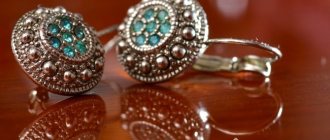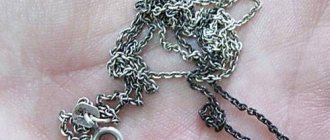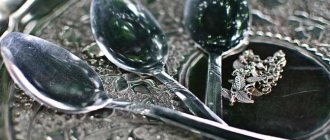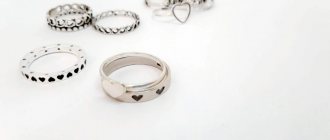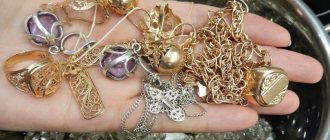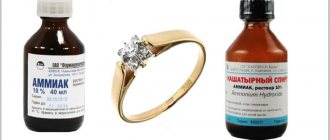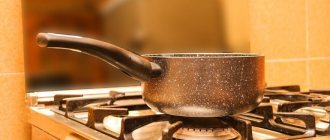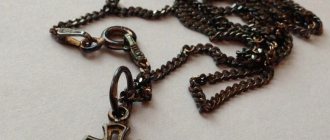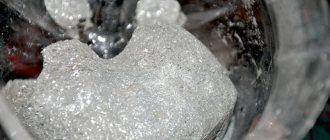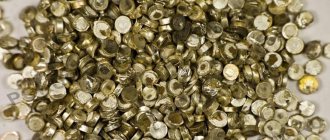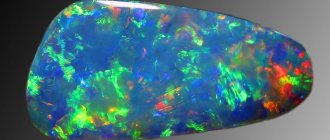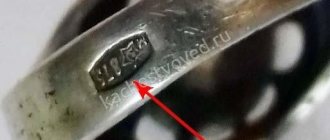Have you noticed that over time, a dark coating forms on your favorite silver rings and earrings? This blackness on jewelry can appear from anything: soap, lotions and body creams, from high humidity and even from the air. It's unavoidable. Any silver, even the highest standard, develops blackness over the years. But this is not a reason to throw your favorite silver items into a corner and never wear them again. There are many ways to remove dark plaque on your own.
We have collected effective ways to clean silver from blackness at home.
Why does silver darken?
External irritants, improper care and storage - all these are the reasons for the appearance of blackness. The main “enemy” of silver is sulfur, or more precisely hydrogen sulfide. Under the influence of sulfur and its oxides, silver products are covered with a thin blackening film. It is impossible to avoid the effect of hydrogen sulfide on products; it is found almost everywhere, even in the air (thanks to exhaust gases and emissions).
Another reason for the resulting dark coating is the low quality of the metal. If a low-quality ligature and low-quality silver are used, the object will quickly turn black, even without aggressive environmental influences.
But we would like to remind you that even the highest standard 925 silver darkens over time. To delay this moment, craftsmen apply a thin layer of rhodium. This way the decoration stays shiny longer.
In addition, dark plaque may appear due to increased sweating, the use of skincare products, or contact with household detergents.
Once again, the appearance of black on silver is a natural process. And you should only worry if the product quickly darkens in a few days. In other cases, dark plaque can be easily removed on your own.
Rhodium plated
Rhodium plating is a technology with which jewelry factories apply a thin layer of rhodium (thickness - only a few microns). Its chemical properties are similar to platinum.
This type of silver coating protects the item from darkening.
Advantages of this method:
- the decoration does not darken;
- ensures hardness (protects from damage due to careless use);
- adds a special shine to designer jewelry.
Disadvantage: some collectors of natural silver are not impressed by the shine inherent in rhodium plating. They perceive it as unnatural.
How to clean silver: effective ways
There are a lot of options for cleaning silver at home. But not everything is as simple as it seems. First you need to prepare it for cleaning.
First, pay attention to the composition of the metal. It is important to understand what percentage of impurities and which ones are in the item. And only after that choose a suitable cleaning product.
Secondly, before cleaning, take into account the various inserts: stones, fastenings, reliefs. If the jewelry is miniature or has many small relief convolutions, or complex weaving and a scattering of stones, it is better to have the product cleaned by professionals. They know exactly how and with what to clean even hard-to-reach places on the jewelry.
If you don’t want to overpay and are confident that you can handle it yourself, read below and choose the appropriate method for cleaning silver items from blackness at home.
Cleaning with foil and baking soda
Perhaps the most common and effective method is to clean silver with soda.
All you need is: water, baking soda and foil.
- Add 2 tbsp to boiled water. soda
- Place a strip of aluminum foil in there.
- And leave the silver in it for 15-20 minutes.
- Afterwards, rinse the silver under the tap and dry thoroughly.
As a result of the reaction of silver with an alkaline solution, the blackening disappears, and your favorite jewelry returns to its shine and shine, as on the first day of purchase.
But remember, you cannot clean silver with dry soda. Due to the abrasiveness of the product, small scratches may remain on the jewelry, which, of course, will spoil the appearance.
Ammonia
Our grandmothers also used this method to clean silverware and jewelry. An ammonia solution gently removes tarnish, dirt and grease without damaging the surface of the silver item.
The recipe is simple. Add a little ammonia to the water and place silver objects there, leave for half an hour (it can be longer if the blackness still remains). Minimum hassle.
Ammonia is also good because it can remove blackness from products with cloudy stones. This method, although it takes a long time, is not so aggressive and will definitely not spoil your favorite jewelry.
Hydrogen peroxide
You can clean silver with hydrogen peroxide, but be careful. This is because peroxide can both whiten the surface too much and leave cloudiness and residue, especially when the silver alloy contains many other impurities. Therefore, silver is not treated with peroxide alone. But in combination with ammonia, peroxide gives a positive result.
We make an aqueous solution of hydrogen peroxide and ammonia and leave the silver in it for 20 minutes.
Vinegar
If you don't have ammonia at home, you can use good old vinegar. Simply leave silver items in a 6% or 9% vinegar solution and leave for two hours. If this does not help, you can enhance the effect by slightly heating the vinegar. Afterwards, do not forget to rinse well and wipe dry all items.
Citric and other acids
Silver objects can also be cleaned with lemon. All you need to remove blackness is half a liter of water and citric acid. Pour water into a saucepan and add citric acid, bring to a boil and immerse the silver for 15 minutes. You can put some copper object on the bottom to achieve a stronger effect.
Toothpaste
There is certainly toothpaste in every home. To bleach silver, use a pure paste, the most common one. Take a soft cloth or brush, dampen it and apply a small amount of toothpaste, then gently wipe the silver items, being careful not to scratch them.
For greater effect, you can try tooth powder. But be careful. This is not the most delicate cleaning method and is best used only for those items that are not valuable. Make a semi-liquid mass of tooth powder and apply it to a dampened soft cloth. Wipe jewelry in one direction only to minimize the risk of micro-scratches.
Coca Cola
The miraculous abilities of Coca-Cola to get rid of scale and rust are known to everyone, but they are not limited to this. You can also easily make tarnished silver look sparkling with Coca-Cola.
Boil Coca-Cola and cook silver items in it for five minutes. After cleaning, rinse and dry.
Paste GOI
This is already a professional silver cleaner. And it was first obtained at the State Optical Institute, hence the name of the paste. Cleaning with GOI paste is a rather labor-intensive and dangerous method. Since, due to incorrectly selected GOI paste (and there are several types), the surface can be severely scratched.
For silver items, use paste number three. It mattes the surface well and does not leave streaks.
- Apply the paste to a cloth (you can pre-moisten it in gasoline so as not to scratch the silver).
- We process the product patiently. It will take a lot of time, but the result is worth it.
Lipstick
Not the most obvious way, but quite effective. And all thanks to the fact that the lipstick contains fats and titanium dioxide, which help remove dirt quickly and accurately.
Simply take the pomade and apply it to the silver, then gently buff with a cloth until it's squeaky clean.
Soap solution
A simple and safe way to clean your silver and keep it sparkling. It won’t cope with heavy stains and ingrained blackness, but it can handle light darkening quite well. Plus, this way you can clean objects with stones. Leave silverware or jewelry in the soapy solution for twenty minutes. You can “massage” items with a soft toothbrush for a deeper clean.
Salt
Ordinary salt is also a good way to remove blackness from the surface of silver items. Make a saline solution per 1 glass of one teaspoon of salt and boil the decorations for 10-15 minutes.
Silver products without sputtering
Please note that plating is not always used for silver items. At auctions you often find chains, cufflinks and brooches made from 925 sterling silver. There is no external coating on them. How to distinguish them? External feature: natural shine. It can be enhanced by polishing the bracelet or ring. Or, conversely, make the surface of the decoration look more matte.
Silver items that do not have a coating can be recommended for people who have overly sensitive skin. In addition, scientists have proven that objects made from this metal have antibacterial properties.
There are nations that endow silver with special magical powers. For it to be transmitted to humans, direct contact with the skin is required. It is for this reason that sputtering is not used in collections created by Yakut masters.
Uncoated jewelry has only one drawback: over time, it can fade and darken. But it’s easy to clean souvenirs made of this metal at home. It is better to entrust the cleaning of rare items to specialists in salons.
How to clean silver with stones
Jewelry with stones requires especially careful cleaning. First of all, you need to know exactly what type of stone is inlaid into the product. The cleaning method will depend on this.
- Emerald, sapphire, aquamarine - these stones have a high density, and therefore they are not afraid of anything. You can safely boil such decorations and clean them with soda and ammonia.
- Garnet, ruby - but these stones do not tolerate high temperatures, so it is better to avoid boiling. More gentle cleaning methods are suitable here.
- Jewelry with malachite, turquoise, opal, moonstone - do not clean them with abrasives, these are delicate stones. It is better to limit yourself to a soft cloth soaked in diluted alcohol and a bath of soapy water. But don't leave them in the water for a long time, they don't like it.
- Pearl, amber, mother-of-pearl and coral stones are the most sensitive. A reliable way to avoid damaging your jewelry is to have it cleaned by a professional. If you still want to try it yourself, use only a soft, damp cloth to clean the surface of the stone, and for a silver base, try a school eraser.
Oxidation
The products are treated with a special composition, in which the main ingredient is sulfur. Thanks to this treatment, unusual color transitions appear on the treated surface. The intensity of the polishing process determines the shade that the silver will acquire.
The jewelry, on which the thinnest film is applied, is polished. As a result, the convex parts become lighter, and the concave parts are visually perceived as dark. Oxidized silver does not require complex care. It is enough to moisten a cotton napkin with soapy water and wipe the product, and then dry it with a dry cloth.
Cleaning blackened silver at home
There are only two ways to clean blackened silver - soapy water and potatoes.
- Prepare a soap solution with soda and soak the silver in it for half an hour. You can go over the surface with a toothbrush without pressing hard.
- Place 3-5 peeled potatoes in cold water and leave the blackened silver in this water for 3-4 hours. Afterwards, we rinse it with tap water, and if the dirt remains somewhere, you can go over the surface with an eraser.
Gilding
A thin layer of gold plating is applied to the product. Basically, 750-carat gold is used for this technology. But there are exceptions when the manufacturer uses higher quality metal. Sputtering with precious metal does not affect the declared sample in any way.
The cost of silver items when gilded increases. With constant contact with an aggressive alkaline environment, the gold plating layer can quickly decrease. Therefore, it is recommended to take care of things that have such a coating (remove them before taking water procedures, do not swim with them in the pool). If you follow these simple recommendations, your gold-plated silver jewelry will look great and could easily become a family treasure.
Do you like stylish things inlaid with stones? If you are not indifferent to boxes, cigarette cases, brooches, then go to the online catalogs of our website - you can find a lot of interesting things for your collection in them.
Silver is a great choice for necklaces, rings, bracelets or other accessories to enhance your wardrobe. This metal is versatile and adds a fashion-forward look to casual wear or soft elegance to dressier ensembles.
However, one of the most common complaints about silver items is the metal turning black over time. How can I clean black deposits from silver items? Why does silver actually tarnish? Can you prevent this?
Every piece of silver jewelry develops a black coating after some time. This is the result of a chemical reaction that occurs when silver comes into contact with air and various substances.
Silver tarnish is a form of corrosion, but unlike rust, it does not attack the metal itself and can be removed relatively easily.
How to care for silver
Silver is an exquisite and noble metal that requires special treatment and careful care.
- Don't forget about regular cleaning. Don’t let it get to such an extent that only a professional can handle the dark plaque and no home methods will work.
- It is better to leave harsh abrasive products for other needs.
- It is better to remove jewelry when cleaning or playing sports.
- For 925 sterling silver, use only professional products. Or take it to a workshop.
- 3 days after cleaning, a natural protective film appears on the silver. Leave the decorations to sit for this period of time.
- And, of course, store in suitable conditions so that the silver does not darken.
Storage.
Air humidity, oils from your skin, perfumes, lotions, hair products and other chemicals can cause corrosion and tarnishing of the product. Typically, to slow down the tarnishing process, you should store your silver jewelry with minimal exposure to moisture and air.
Place your silver items in tightly sealed bags. You can also insert a pouch of silica gel and store it with your jewelry. Small packets of silica gel absorb moisture and thus help delay tarnishing.
Protect your jewelry by wiping it completely with polishing pads or other soft material before storing it.
Store your silver in a dark, dry place such as a jewelry box or drawer. It is advisable to have enough space for each piece of jewelry.
It is best to store jewelry so that they do not touch each other. Storing your jewelry in this way ensures that it will look attractive for many years to come.
Polishing with baking soda, vinegar and aluminum foil
No less effective way. To do this, you need to prepare a deep and capacious bowl. Cover all inner walls of the container with foil. At the same time, the foil should fit as tightly as possible to the bowl, covering every centimeter of the walls of the dish.
To boil water. The amount of liquid depends on the size of the silver item - it must be completely covered with water.
Add a tablespoon of soda, the same amount of salt and 200 ml of white vinegar to the water. If the product is large, you should double the number of components.
Mix everything thoroughly. Each grain of sand must completely dissolve in water - this is very important!
After boiling completely, add more water and mix everything thoroughly again. Using tweezers, lower the products into the solution for 2-3 minutes.
After the silver has been in the liquid for the required time, remove it and wrap it in a soft towel. Once the items have cooled down, you can begin polishing.
Polish the silver with a soft sponge or cloth, paying special attention to stubborn plaque.
